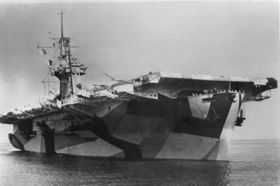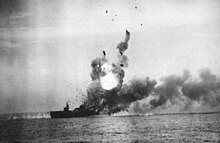USS St. Lo (CVE-63)
 The USS Midway (CVE-63) in San Diego, April 1944 |
|
| Overview | |
|---|---|
| Type | Escort aircraft carrier |
| Keel laying | January 23, 1943 |
| Launch | August 17, 1943 |
| Namesake |
Battle of Midway / Battle of Saint-Lô |
| 1. Period of service |
|
| Commissioning | October 23, 1943 |
| Whereabouts | Sank on October 25, 1944 after being hit by Kamika |
| Technical specifications | |
| displacement |
7800 ts (standard) |
| length |
156.2 m |
| width |
32.9 m |
| height |
34.5 m (mast) |
| Draft |
6.9 m |
| crew |
860 |
| drive |
4 piston steam engines, 9000 HP on two propellers |
| speed |
19 kn |
| Range |
10,200 nm at 15 kn |
| Armament |
|
| Planes |
28 |
The USS Midway (CVE-63), formerly USS Chapin Bay , on October 10, 1944 renamed the USS St. Lo , was an escort carrier of the Casablanca-class in the service of the United States Navy during World War II in the Pacific. The carrier, which entered service with the US Navy in October 1943, sank after only one year of service during the Battle of Samar after a devastating kamikaze hit on October 25, 1944.
technology
The St. Lo was 156.2 meters long and a maximum of 32.9 meters wide, the draft was 6.9 meters, the operational displacement was 10,400 tons . The drive from four piston steam engines acting on two shafts with a total output of 9,000 hp brought the ship to a top speed of 19 knots . The range was 10,200 nautical miles at 15 knots cruising speed . In addition to the barrel armament consisting of a 127 mm gun, eight 40 mm twin flaks and 20 20 mm automatic cannons, the carrier had a Carrier Air Wing with around 25 to 30 aircraft, mostly a "composite squadron" (Eng. "Combined Squadron ”) consisting of fighters and torpedo bombers for anti-submarine missions .
history
Construction and commissioning
The carrier was laid down as the USS Chapin Bay at Kaiser Shipyards in Vancouver , Washington on January 23, 1943 . On August 17, 1943, the carrier, which had been renamed USS Midway on April 3 , was launched, the commissioning with the US Navy took place on October 23, 1943 under the command of Captain Francis J. McKenna , after just nine Months total construction time. After commissioning, the carrier was tested off the US west coast.
First missions and renaming
After two trips to Hawaii and a visit to Australia, the Midway was assigned to Carrier Support Group 1 under Rear Admiral Gerald F. Bogan in June 1944, which should support the American operations against the Mariana Islands. On June 15, Midway aircraft secured the American landing on Saipan , and on July 23, they provided air support for US troops on Tinian . On September 13, 1944, the Midway ran to Morotai , where its on-board aircraft flew their first air raids two days later. The operation lasted until September 23, then the porter ran to Palau , where it arrived on October 3. On October 10, the Midway was renamed the USS St. Lo in commemoration of the Battle of Saint-Lô to free the name Midway for a new fleet aircraft carrier .
Battle for Leyte
On October 12, the St. Lo ran from Palau towards the Philippine island of Leyte , where its aircraft were supposed to provide air shielding against enemy aircraft and close air support during the bombing and amphibious landings of the American troops. The USS St. Lo belonged to the escort unit "Taffy 3" (TU 77.4.3), which consisted of six escort carriers with seven destroyers. On the east coast of Leyte and on Samar, the planes of the USS St. Lo attacked airfields and other military targets from October 18 to 24. On October 25, 1944, the remaining carriers of Taffy 3 were assigned to air strikes against the landing beaches, while the USS St. Lo was assigned to shield against enemy attacks from the sea. In the morning, a submarine patrol of four aircraft started aboard the USS St. Lo .
The battle off Samar began at 6:47 a.m. when the pilot of a TBM Avenger from the USS St. Lo reported the sighting of a large Japanese task force consisting of four battleships, six heavy and light cruisers and destroyers from the west-northwest. At the same time, the lookout of the USS St. Lo also discovered the characteristic structures of the Japanese battleships on the horizon. Admiral Takeo Kurita opened fire on the US unit at around 6:58 a.m. In the next 90 minutes, firing Japanese cruisers and destroyers came within 9,100 m of the USS St. Lo . Many enemy volleys hit the water just before the ship or just overflown it. The US escort carriers and destroyers put an artificial smoke screen around the formation during the battle. This smoke screen and a natural rain front prevented targeted bombardment of Taffy 3. In addition, the Japanese warships were hindered by attacks by US destroyers and aircraft attacks. In addition to Taffy 3 aircraft, the aircraft attacks were also carried out by aircraft from two US aircraft carrier formations further south.
The USS St. Lo shot back with its only 127 mm gun during the battle. The crew of the USS St. Lo claimed after the battle that three shells hit an enemy cruiser. The USS St. Lo itself was not hit during the engagement. If the shells of the USS St. Lo actually hit the Japanese cruiser, for which there are only US soldiers of the on-board crew as witnesses, the ship would be the only aircraft carrier in the world to date to have hit an enemy warship with on-board weapons.
After the massive attacks by US planes and destroyers, the Japanese fleet finally had to turn away. Three Japanese cruisers were sunk by US planes and another was badly damaged.
Around noon, the Taffy 3 escort unit was the target of kamikaze attacks . An aircraft struck the USS St. Lo , penetrated the flight deck and exploded in the lower hangars where the carrier's aircraft were being refueled. A big fire broke out and after half an hour the ship sank. A total of 163 crew members were killed.
Web links
- History of St. Lo in the Dictionary of American Naval Fighting Ships (English)
- Pictures of St. Lo at navsource.org
- USS St. Lo Association (Engl.)
